Abstract
It has been argued that the increase in the consumption of dogs in the southern Levant during the Iron Age was due to the advent of the Philistines/“Sea Peoples” into the region. In this study, we test this proposal through the presentation of new information on dog consumption and its depositional context in Bronze and Iron Age strata from the archaeological site of Tell Zirāʿa (Jordan), and we compare the results to other sites in the region. Our study does not support that such behaviour is a signal of ethnic identity.
Keywords:
archaeology; near east; Philistines; Sea Peoples; ethnicity: diet; Canis familiaris; domestic dog 1. Introduction
Dogs, as friends and helpers to humans, have been around for more than 20–30,000 years and were used as pets, for hunting, guarding settlements, herding, as “rubbish scavengers”, etc. [1,2,3,4,5,6]. In effect, dogs are the original example of a species domesticated for their secondary products—humans benefit from the animal while keeping it alive [7,8,9]. Yet, the frequency of dog bones mixed in with food debris suggests that they have also played a significant role in subsistence as primary products [10].
It has been argued that the increased presence of domesticated dog (Canis familiaris) bones in archaeological assemblages from the earlier Iron Age (Iron I) in the southern Levant is an archaeological marker for the advent of the Philistines/“Sea Peoples” into the region [5,11]. This proposition links dog consumption (cynophagy) with a specific ethnic/cultural group that was not present in the region before the Iron Age. This argument implies that the disarticulated (loose) dog bones found in faunal assemblages from this period reflect canid consumption.
Dogs appear in many types of archaeological contexts, of which only some may imply actual consumption. They are found in special contexts (e.g., ritual, mortuary, and other such deposits) [12,13,14,15,16,17]. They are also found mixed in with food debris. The presence of loose dog bones in and among food debris assemblages may suggest canids that were also consumed [5,10,18,19,20]. Yet it is difficult to truly determine whether the loose canid bones in zooarchaeological assemblages really represent food debris or are simply remains that became disarticulated for a variety of reasons.
Rather than relying on the presence of disarticulated osteological elements, consumption of dogs can be more accurately determined by the presence of butcher marks (i.e., slices, bashes, and chops) [21,22,23,24], discolouration, and morphological changes on bones heated during cooking (burning, boiling) [25,26]. The location and intensity of butcher marks will vary depending on the process of meat production [5]. Evidence of these marks can be used to determine whether canid remains were in all probability consumed, as well as whether canid consumption can be associated with a particular ethnic group during the Iron Age in the southern Levant. Rather than focusing on the frequency of dog osteological elements in Philistia-associated depositional contexts to determine if cynophagy is associated with Philistine behaviour, we chose a different approach. With our approach, it is necessary to also examine dog osteological element frequencies in periods prior to the appearance of the “Sea Peoples” in southern Levantine settlements.
In this article, we hope to contribute to the issue of Philistine dietary characteristics based on a new evaluation of the canid bones from Tell Zirāʿa. It is one of the few sites in the region with a systematically excavated and analysed zooarchaeological assemblage that extends from the Early Bronze Age through the Iron Age (Table 1).

Table 1.
Stratigraphy and chronology of Tell Zirāʿa.
Table 1.
Stratigraphy and chronology of Tell Zirāʿa.
| Stratum | Date | Period | Abbreviations |
|---|---|---|---|
| Stratum 24 | 3000–2700 BCE | Early Bronze Age II | EB II |
| Stratum 23 | ca. 2700 BCE | Early Bronze Age II/III | EB II/III |
| Stratum 22 | 2700–2300 BCE | Early Bronze Age III | EB III |
| Stratum 21 + 20 | 2300–1950 BCE | Early Bronze Age IV/Middle Bronze Age I | EB IV/MB I |
| Stratum 19 + 18 | 1950–1750 BCE | Middle Bronze Age IIA | MB IIA |
| Stratum 17 | 1750–1630 BCE | Middle Bronze Age IIB | MB IIB |
| Stratum 16 | 1630–1400 BCE | Middle Bronze Age IIC/Late Bronze Age I | MB IIC/LB I |
| Stratum 15 | ca. 1400 BCE | Constructional | |
| Stratum 14a-d | 1400–1200/1050 BCE | Late Bronze Age IIA/B | LB IIA/B |
| Stratum 14a | 1300–1200/1150 BCE | Late Bronze Age IIB | LB IIB |
| Stratum 13 | 1200/1150–1000/980 BCE | Iron Age I | IA I |
| Stratum 12 + 11 | 1000/980–700 BCE | Iron Age IIA/B | IA IIA/B |
| Stratum 10 | 700–520 BCE | Iron Age IIC | IA IIC |
| Stratum 9 | 520–332 BCE | Persian | Persian |
2. Dog Consumption in the Iron Age in the Southern Levant
In general, from the Early and Middle Bronze Ages in the southern Levant, there are very few isolated dog bones that might represent consumption (e.g., Tall al-Umayri, Hazor, and Tel Kabri [27]). None of the Early Bronze specimens are reported as having any butcher marks or any other unambiguous evidence of the consumption of these animals. From the Middle Bronze Age, only one infant dog specimen found in the cultic area at Tel Haror has been recorded as having butcher marks [27,28]. Similarly, very few dog bones are known from Late Bronze Age settlements (e.g., Beth Shemesh or Hazor), and only a single dog bone with butchering slice marks has been identified from Lachish. At the very least, in this latter case, a dog is likely to have been slaughtered (Figure 33.22.8 [27,29]).
There is occasional evidence of the consumption of dogs in the form of butchered dog bones throughout the Bronze and Iron Ages sites in Anatolia, Europe, and Greece [27], as well as both the northern and southern Levant [30,31]. For example, at Kavousi-Kastro and Kavousi-Vronda (Crete), dog bones compose less than 2.5% of faunal assemblage, a relatively minor quantity. This stands in comparison to the higher quantities of pig and cattle (8.5% each) and ovicaprine bones (almost 80%). Furthermore, many of the dog bones exhibit slice and chop marks [6,31]. Cynophagy, in particular, was widespread and long-lasting in the Aegean region (with a focus in southern Greece and Crete), as well as used regularly in Anatolian ritual contexts [14,27,32]. This pattern continues into the Classical era [12,16].
Dog consumption is seen, among other things, as further evidence of a non-indigenous origin for the Philistines [27]. While dog consumption has been suggested to reflect Philistine behaviour, the disarticulated dog remains mixed into the larger faunal debris at Philistine sites such as Tel Miqne-Ekron suggest that dogs formed a small but consistent part of their diet (i.e., 0.1% or less from Tel Miqne-Ekron, Tel eṣ-Ṣâfi/Gath, etc.). In addition, a few dog bones without butchering marks have also been recovered from Iron Age contexts at Tel Dor, Khirbat al-Mudayna, and Tell Afis [27].
Dog bones in general make up a very small and quantitatively insignificant proportion of the zooarchaeological assemblages in the region. The consumption of dog meat is rare compared to the “normal” meat exploitation pattern from other domestic animals (e.g., sheep, goats, pigs, and cattle) that made up the bulk of the diet [33,34]. Supposedly, the habit of consuming dogs was not practised at these sites before the arrival of the Philistines or among the contemporary Levantine cultures of Iron Age I.
Evidence for the use of dogs in rituals (such as being slaughtered, buried in special locations, and/or otherwise suggestive of having been sacrificed) has been found in deposits from the Iron Age I period at Tel Miqne-Ekron (decapitated puppy burials, eight examples—[decapitated puppy burials, 8 examples] [5,27]), at Ashkelon (two infant dog skeletons with butchering marks characteristic of skinning were found buried in a ceramic vessel as a foundation deposit—[where two infant dog skeletons with butchering marks characteristic of skinning were found buried in a ceramic vessel as a foundation deposit] [11]), Tel Miqne-Ekron (dog burial near a cultic installation—(dog burial near a cultic installation [35])), Ashdod [36], Ashkelon (eight samples from Iron Age I fill—[8 samples from Iron Age I fill] [5]), and others [5].
Consumption of dogs cannot be explained as a temporary action during time of crisis for survival, such as when meat was not easily available due to climatic, seasonal, military, or other factors. Dog consumption does not appear only during a time of crisis (e.g., as a stopgap measure) because people otherwise had no meat. There was always also the possibility to hunt wild animals for protein extraction [5]. The overwhelming abundance of non-canid animal bones in Iron Age assemblages suggests that people had access to plenty of meat and did not have a poor diet that was low in protein and fat. Therefore, the very low frequency of dog bones in zooarchaeological assemblages suggests that dogs were consumed infrequently. The articulated dog burials suggest, in many cases, that they were probably for ritual purposes [27]. In other cultural contexts, the disarticulated bones in faunal assemblages are interpreted as consumption of an unusual delicacy (e.g., [19], for Oman). In general, it does not seem that dog meat was consumed daily during the Iron Age in the southern Levant. Perhaps it was only on special days and/or festivals. Only spatially and contextually oriented analyses may eventually answer this question. In this paper, we examine the issue chronologically to determine if such behaviour appeared without foundation with the advent of the Philistines (or other “Sea Peoples”) at the end of the Late Bronze Age or beginning of the Iron Age I period.
3. Butchered Dog Bones from the Iron Age in the Southern Levant
To date, very few dog bones with traces of butchering marks have been noted in zooarchaeological assemblages from the southern Levant during the Iron Age I and II periods. Where present, dog bones with butchering marks typically make up no more than one per cent of canid remains, although the distribution of butchering marks on the skeleton is found in a similar arrangement on the bones of other domestic animals.
Various dog bone specimens bear butchering marks characteristic of food preparation, such as disarticulation, carving, and filleting. Butchering marks on the distal osteological elements (e.g., metapodia) suggest that they may have been skinned for their fur [5]. Some bones without evidence of butchering marks show evidence of discolouration from burning, which is possibly the result of frying or cooking meat [27].
Several examples of butchered and disarticulated dog specimens have been recovered from Iron Age I sites in Philistia e.g., Ashkelon, Tell Jemmeh, Jaffa [5], Qubur el-Walaydah [5], and Tel Miqne-Ekron [35]. Slice marks have also been found on fox bones. A total of 16 dog and 3 fox bones with such traces could be detected from six Iron Age urban sites [5].
Canid bones with traces of butchering from Iron Age II deposits are largely restricted to sites in Philistia, including Tel Miqne-Ekron and Tell el-Far’ah-South, and from an Iron Age IIA context at Tell eṣ-Ṣâfi/Gath ([5,33,37] [4 samples]). With the exception of three bones from Tel Rehov in the northern Jordan Valley, there is poor representation of dog bones in the northern half of the region [38,39]. If there are dog bones listed in the excavation reports, there is no mention of butchering marks e.g., [40]. For example, the report from Tell Abu al-Kharaz mentions two dog bones but does not provide any information about butchering marks or traces of burning [40]. At Pella, some dog bones were found in the relevant strata, but none with butchering marks (S. Bourke, pers. comm.).
Dog consumption appears to change between the Iron Age I and II periods in Philistia. There is a precipitous decline in dog bones between the two periods, with the percentage of butchered canid bones from Philistine sites being only fifteen percent (6 of 39 NISP) recovered from post-Iron Age I contexts [5,27]. From the above data, several scholars have concluded that dog sacrifice and consumption (i.e., eating) was an Iron Age I (and later) custom [5,11,33]; however the decline in dog bone frequency would suggest that dog consumption is not a characteristic of later Philistine sites.
4. Dog Consumption at Tell Zirāʿa
4.1. The Site
The excavation of Tell Zirāʿa began in 2001 and continues as part of the Gadara Region Project under the directorship of Prof. Dr. Dr. Dr. h.c. Dieter Vieweger and Dr. Jutta Häser. The site occupies a central strategic position, as it lies where the Wadi el-‘Arab and the Wadi es-Zahar meet (Figure 1 and Figure 2). While the tell rises about 25 metres above the surrounding area, its highest point is still 17 metres below sea level. The settlements on the tell were built on a natural limestone hill, which has a diameter of about 240 metres at its base, and the plateau measures 160 metres in diameter. The sequence of cultural layers ranging from the Early Bronze Age to the Islamic period is approximately 16 metres thick (Table 1).
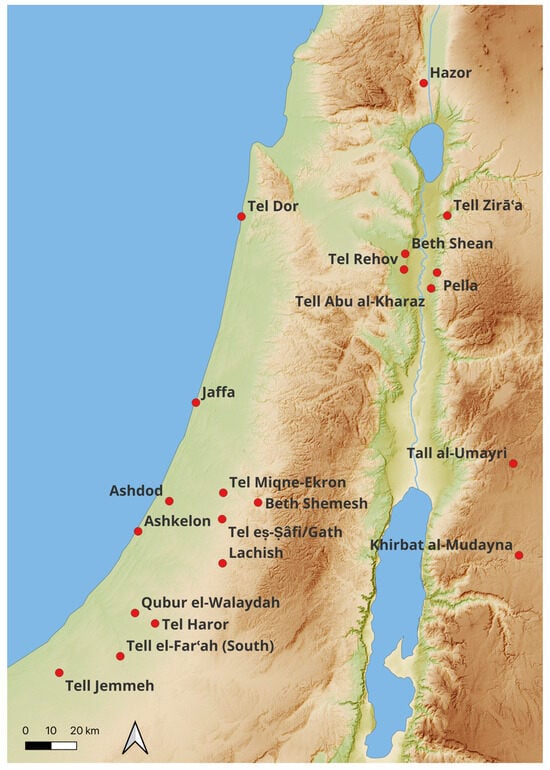
Figure 1.
Map of the southern Levant showing the location of many of the significant archaeological sites mentioned in the text.
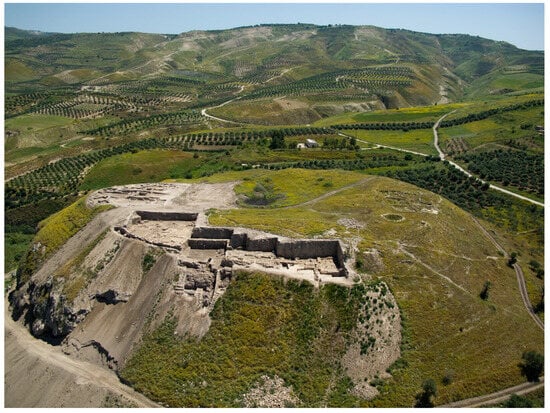
Figure 2.
Tell Zirāʿa, as seen from above, viewed from west to east. The large excavation, Area I, is in the front where superimposed deposits were excavated from the Early Bronze Age through the Iron Age.
The special regional importance of Tell Zirāʿa stems from three facts about its location, as follows:
- First, there is an active artesian spring on top of the tell. It must also have been an attractive, beneficial, and wondrous phenomenon in the past, as it yields a constant flow of water (at least until the modern irrigation system in the valley diverted its flow).
- Second, the tell has a strategic position along an ancient and highly important trade route. It controls the ascent from the Jordan River Valley bottom (c. 290 metres below sea level) to the escarpment for the Irbid-Ramtha-Area and the hills west of Bait Rās (c. 560 metres above sea level). This steep ascent over a short distance can be surmounted via the Wadi el-‘Arab without steep or narrow passages. The Wadi el-‘Arab is an ideal and historically known route that connects the trade routes along the Mediterranean littoral via the Jordan valley with the high escarpment of Transjordan to the east and with Damascus and Mesopotamia to the north-east.
- Third, the tell contains evidence of over 5000 years of settlement—without any long and significant cultural gaps. As far as archaeology is concerned, this is perhaps its most important feature. It means it is possible to observe not only cultural change from period to period in a single location but even the transitions between them when there is evidence of continuity [41,42,43].
4.2. The Transition from Late Bronze Age to Iron Age I at Tell Zirāʿa
The latest Late Bronze Age stratum (after 1400 BCE) was exposed across a large area of the site (1750 m2). The most striking structure in this stratum was a massive casemate wall, which protected the settlement’s north-western flank. In the south, the casemate wall ended in a large tower protruding inward toward the town, which included a partitioned long-room temple. In the yard to its east was an altar covered with ceramic sherds. The combination of monumental architecture in conjunction with the valuable artefactual finds speak to the importance of this Late Bronze Age town as a trade and craft centre. Here, ceramics, metal, glass, pottery, and quartz frit (a product used to make glass) were produced or processed. Therefore, it is quite conceivable that during the Late Bronze Age, Tell Zirāʿa was the centre of a small city-state.
Around 1200/1150 BC, the Late Bronze Age town at Tell Zirāʿa was partly destroyed. It is not possible to determine whether this was due to an earthquake or conflict. However, this dramatic episode did not mean the end of the settlement. The artesian spring and the outstanding settlement conditions around the tell very likely allowed the population to remain in the area even after the disaster, as they were able to continue supporting growing crops and herding animals as part of their livelihoods.
It is particularly striking that, during Iron Age I (Stratum 13), the inhabitants did not create a new and different settlement layout. They built their homes and other facilities atop and against the remains of the Late Bronze Age town wall, despite its considerable destruction. In contrast to the Late Bronze Age, the site was no longer walled. It would be wrong, however, to associate the Iron Age I occupation with the idea of “decline”. While it did not reach the level of the “sophisticated” urban culture of the Late Bronze Age, the finds of the Iron Age I period provide an eloquent testimony of the cultural level during this period: there is evidence of the production and consumption of fine crafts as well as the creation of monumental public architecture. There is a temple and its facilities in the northern part of Area I with evidence of glass processing and carefully built courtyard houses in the south, along with outstanding, finely produced, high-quality objects.
It is particularly interesting that, on the one hand, the architecture continued the layout and pattern of the Late Bronze Age courtyard houses (in the southern excavation area of Area I). On the other hand, the Iron Age innovation of the four-room house was introduced, as can be seen in the northern area. The central part of Area I, however, was probably used for storage and stables. It had no permanent buildings ([44], For a detailed analysis of Late Bronze Age and Iron Age strata see [45,46]).
Tell Zirāʿa offers decisive clues about changes in the demographic structure of the region and site toward the end of the Late Bronze Age. Many things (e.g., architecture, cult, pottery, small finds) point to the arrival of non-indigenous people—probably bringing an Aegean influence with them [47].
4.3. General Faunal and Dog Assemblages
At Tell Zirāʿa, a very large and systematically analysed zooarchaeological assemblage was recovered (Total 55,224 NISP; 74,000+ fragments) from stratigraphically superimposed and chronologically secure deposits from the Early Bronze Age through the Islamic period [48]. Dog bones are recorded in almost every stratum from the Early Bronze Age to the Modern period (N = 82 in total with each fragment representing a separate individual) plus a single wolf. There is only a single articulated dog specimen (maxilla with teeth, radius, and ulna that seem to be from the same specimen) from the MB IIA stratum (Table 2).

Table 2.
Frequency distribution of all Canis familiaris (domestic dog) specimens at Tell Zirāʿa by chronological period. Frequency of Column reflects the sum of all Canis familiaris specimens for all periods. Frequency of Row reflects the percentage of Canis familiaris specimens in the general assemblage for each time period. Total NISP of all taxa indicates the total frequency of all bones in a particular time period. Highlighted rows are the Late Bronze Age II and Iron Age data. NISP = Number of individual specimens.
4.4. Butchered Bone Frequency Distribution by Period
In general, there are very few domestic dog specimens (between 1 and 7 NISP) per time period from the Early and Middle Bronze Ages (Table 2). A slight overall frequency increase can be observed between the Late Bronze Age (N = 16; 19.51% of column total) and Iron Age I (N = 18; 21.95% column total). This pattern continues into the Iron Age II period (N = 17; 20.73% column total).
However, this seeming increase during the LB and IA is undercut when the dog bone raw frequency (absolute number) is compared with the total NISP for each of these phases (row total). Instead, the EB has the highest relative (%) frequency of dog specimens, while the dog bone frequencies in later strata are remarkably lower. In other words, based simply on the adjusted relative frequencies of dog specimens, there is no evidence of a dramatic increase in so-called “Philistine”-associated deposits. All discussions of dog bones need to take this quantitative issue into account. Raw frequencies must be adjusted relative to the overall sample size.
In order to determine if there was any significant increase in butchered dog bones, all of the dog remains from the Early Bronze Age (EB III, Stratum 22) through the Iron Age deposits (IA IIC, Stratum 10) were re-examined for butchering marks (N = 59), as such information was not part of the initial faunal analysis and report [48]. All of the remains are available for examination in the German Protestant Institute of Archaeology in Amman’s storage unit in Umm Qais, Jordan.
The single wolf bone does not show any butchering marks and is not included here. Butchered domestic dog bones were not identified in the EB I and II assemblages. Out of the 59 dog bones re-examined from the EB III through the IA II strata, only 18 display butchering marks (Table 2). Butchered bones are few but ever present through these periods. Except for a slight increase in Iron Age II, the proportion of bones with butchering marks remains fairly constant over time.
The frequency of butchered dog bones vis-à-vis all other butchered bones in the same stratum follows the same pattern as seen with overall dog bones (Table 3). This is evident from the Pearson’s R correlation of the covariation in frequencies, which indicates a very high positive correlation between the number of dog bones and the number of butchered dog bones per major time period (0.871034679—Table 3).

Table 3.
Frequency distribution of all and butchered Canis familiaris (domestic dog) bones by stratum at Tell Zirāʿa (NISP—Number of identified specimens) by chronological periods. Frequency of Column reflects the sum of all butchered Canis familiaris specimens for all periods. Frequency of Row reflects the percentage of all butchered Canis familiaris specimens in the general assemblage for each time period. Total NISP indicates the total frequency of all butchered bones from all taxa in a particular time period. NISP—Number of identified specimens.
The EB has the highest relative frequency of butchered dog bones (0.72%), followed by a severe decline in the MB (0.11%), which is followed by an increase in the LB (0.20%) and IA I (0.18%). The IA II (0.8%), however, experiences a dramatic increase in frequency, contrary to the overall dog pattern seen above, where a decline in frequency is observed (Table 3).
4.5. Cooked Bones
Of the 62 dog bones from the Bronze and Iron Age strata, only seven dog bones display evidence of having been cooked/heated in the form of burning and boiling. Boiled bones are found in the EB II/III (3 NISP) and IA II A/B strata (2 NISP), while burned bones are found in the IA I (2 NISP). Only the EB cooked dog specimens display any evidence of butchering marks (Table 4). The vast majority were not cooked (55 NISP). The general dog bone assemblage distribution is contrasted with that of the butchered dog bones, where only a single dog bone appears to have been cooked (from the EB II/III).

Table 4.
Frequency distribution of cooked (burned and boiled) and uncooked Canis familiaris (domestic dog) by stratum at Tell Zirāʿa (NISP—Number of identified specimens) by time period.
4.6. Butchered Osteological Element Distributions
The distribution of osteological elements for the general and butchered dog assemblages covers most parts of the skeleton when all periods are combined (Table 5a,b). Even in the smaller butchered assemblage, most parts of the dog skeleton are represented when all periods are combined. In both cases, there does not seem to be any selectivity toward specific parts of the skeleton.

Table 5.
(a,b) Frequency distribution of all (a) and butchered (b) Canis familiaris (domestic dog) osteological elements at Tell Zirāʿa by period (Number of elements). Bold numbers are for sums of each time period.
When the butchered dog data are broken down by period, the frequencies are too low to represent the entire skeleton (Table 5a). In the EB III, there is a single rib and metacarpus. None are present in the IB. There is a single rib in the MB IIB and a vertebra in the MB IIC. In the LB II, there is a wider representation with a humerus, femur, and calcaneus, while there are three vertebrae in the LB I. In the IA I, there is a humerus and a calcaneus, an innominate in the IA I/II, and a scapula, humerus, innominate, tibia, and astragalus in the IA II A/B. A lone innominate was found in the IA IIC deposit.
4.7. Age at Death Distribution
The age at death distribution for the general (all) dog assemblage versus that of the butchered is not very different (Table 6a,b). In general, the age categories of all dog bones and all butchered dog bones are heavily weighted toward adults in each period, except where there are only one or two specimens (e.g., Early and Middle Bronze Ages). This is true for both categories of dog bones. However, among the larger dog assemblage, there are age categories that are not represented in the butchered assemblage (i.e., juveniles). Even so, there is no clear indication of a preference for young animals such as seen used in rituals in sites associated with Philistine behaviour in either the general or butchered dog assemblage [27].

Table 6.
Frequency distribution of age-at-death for all (a) and butchered (b) Canis familiaris (domestic dog) bones by time period at Tell Zirāʿa (NISP—Number of identified specimens).
Table 6.
Frequency distribution of age-at-death for all (a) and butchered (b) Canis familiaris (domestic dog) bones by time period at Tell Zirāʿa (NISP—Number of identified specimens).
| (a) | ||||||||||
| Period | Juvenile | Subadult | Subadult/Adult | Adult | Total | |||||
| NISP | % | NISP | % | NISP | % | NISP | % | NISP | % | |
| Early Bronze | 0.00% | 1 | 25.00% | 0.00% | 3 | 75.00% | 4 | 100.00% | ||
| Early Bronze IV/Middle Bronze I | 0.00% | 0.00% | 1 | 100.00% | 0.00% | 1 | 100.00% | |||
| Middle Bronze | 1 | 33.33% | 1 | 33.33% | 0.00% | 1 | 33.33% | 3 | 100.00% | |
| Late Bronze | 0.00% | 2 | 14.29% | 1 | 7.14% | 11 | 78.57% | 14 | 100.00% | |
| Iron I | 3 | 21.43% | 2 | 14.29% | 0.00% | 9 | 64.29% | 14 | 100.00% | |
| Iron II | 1 | 7.14% | 0.00% | 2 | 14.29% | 11 | 78.57% | 14 | 100.00% | |
| Iron I-II | 0.00% | 0.00% | 0.00% | 1 | 100.00% | 1 | 100.00% | |||
| Grand Total | 5 | 9.80% | 6 | 11.76% | 4 | 7.84% | 36 | 70.59% | 51 | 100.00% |
| (b) | ||||||||||
| Period | Juvenile | Subadult | Subadult/Adult | Adult | Total | |||||
| NISP | % | NISP | % | NISP | % | NISP | % | NISP | % | |
| Early Bronze | 0.00% | 1 | 100.00% | 0.00% | 0.00% | 1 | 100.00% | |||
| Middle Bronze | 0.00% | 1 | 50.00% | 0.00% | 1 | 50.00% | 2 | 100.00% | ||
| Late Bronze | 0.00% | 1 | 16.67% | 1 | 16.67% | 4 | 66.67% | 6 | 100.00% | |
| Iron I | 0.00% | 0.00% | 0.00% | 2 | 100.00% | 2 | 100.00% | |||
| Iron II | 1 | 20.00% | 0.00% | 1 | 20.00% | 3 | 60.00% | 5 | 100.00% | |
| Iron I-II | 0.00% | 0.00% | 0.00% | 1 | 100.00% | 1 | 100.00% | |||
| Grand Total | 1 | 5.88% | 3 | 17.65% | 2 | 11.76% | 11 | 64.71% | 17 | 100.00% |
4.8. Butchering Technology
Most butchering marks are slices made with knife blades, followed by a few chop marks from axes/cleavers/other large instruments (Table 7). The differences between the definition of slice and chop marks has been defined elsewhere (e.g., [49,50,51,52]). Interestingly, there are no bash marks by hammerstone type instruments, contrary to what was seen in the general assemblage [53,54,55,56]. Also, there is no evidence of sawing on any of the bones.

Table 7.
Frequency distribution of butchered Canis familiaris (domestic dog) osteological elements at Tell Zirāʿa by butchering mark type and period (NISP—Number of identified specimens).
In the EB II/III and III deposits, both specimens (a rib and metacarpus) have slice marks (Table 7). In the MB, one specimen (vertebra) has only slice marks, while the other has a slice and break mark (rib). In the LB, one specimen (an LB II vertebra) was chopped, while the three LB I specimens (humerus, femur, and calcaneus) and other two LB II specimens (two vertebrae) display only slice marks. The single chop mark on the LB II vertebra split it in half to dismember the bone.
In the IA I and II assemblages, all of the bones have slice marks from knives (Table 7). A single IA I/II specimen (innominate) displays scrape marks from a knife as the tissue was being filleted off the bone. Bold numbers are for sums of each time period.
4.9. Butchering Function
The location of slice marks on bones can inform and provide insight as to the purpose of the butchering activity (Table 8). Here, we distinguish between disarticulation and dismemberment, which is not clearly distinguished in butchering ethnoarchaeological literature [57,58,59]. Slices at the proximal or distal end of bones suggest they were for disarticulation. Slices on the cranium/mandible and distal elements (e.g., metapodia) can suggest that they were for skinning. Slices in the middle of bones, particularly on the meatier part of the body, are generally for filleting of tissue (meat, fat, sinew, etc.). Chop marks generally are for dismembering bones regardless of joint location [53].

Table 8.
Frequency distribution of butchered Canis familiaris (domestic dog) osteological elements at Tell Zirāʿa by function and period (NISP—Number of identified specimens). Bold numbers are for sums of each time period.
In the EB II/III, the meat was initially filleted off the rib probably for food consumption first and secondarily to make the bone into a tool, as it was also polished afterwards. This is the only canid specimen that seems to have been modified afterward. In the EB III, the metacarpus was disarticulated from the carpals. In the MB IIB, the slice and break mark on the rib was from filleting. In the MB IIC, the slice mark was from disarticulating the sacrum from the innominate. In the LB I, two types of marks were found on vertebra. The chop mark on the vertebra was for dismemberment purposes (to divide the vertebra in half), whereas the slice mark on the vertebra was from disarticulation of the vertebral column. In the LB II, the slice mark was made while separating the calcaneus from more distal tarsals, while the slice marks on the femur and humerus were from filleting activities. In Iron Age I, the two slice marks were to disarticulate the humerus from the radius and tibia from tarsals. In Iron Age IIB, we see a repeat of the Iron Age I disarticulation events (separation of humerus from radius, tarsal from metatarsus, tibia from tarsals, and innominate from femur). A single filleting event was also recorded from this stratum.
In general, the pattern of butchering on the dog bones for the EB and MB periods follows the same pattern as seen for the general assemblage of food animals. The data on butchery for the EB and MB are available elsewhere for the assemblage in general [54]. The nature of the butchered dog assemblage remains does not imply that dogs were treated any differently than other food taxa. This reinforces the suggestion that dog elements were mixed in with the general food debris because they were also being consumed on occasion at least during these periods within the Bronze Age. At this point in time, it is not possible to compare the butchered dog assemblage with that of the larger assemblage for later time periods (LB and IA), as such data were not collected and the assemblage is currently unavailable to the authors.
4.10. Butchering Raw Material
The type of raw material used in the butchering process is as follows (Table 9). In the EB, all of the slice marks were made by chipped stone blades or flakes [55]. The situation begins to change in the MB, as metal knife marks begin to be noted (Figure 3, Figure 4 and Figure 5). Metal blade technology continuously increased through to the IA, when all of the specimens were sliced with metal tools (likely iron blades). Already in the LB, even the chop marks were made by metal tools. This pattern parallels that seen in the larger butchered assemblage [55,56].

Table 9.
Frequency distribution of butchered Canis familiaris (domestic dog) osteological elements at Tell Zirāʿa by type of raw material, butchering technology, and period (NISP—Number of identified specimens). Bold NISP numbers are for sums of each time period.
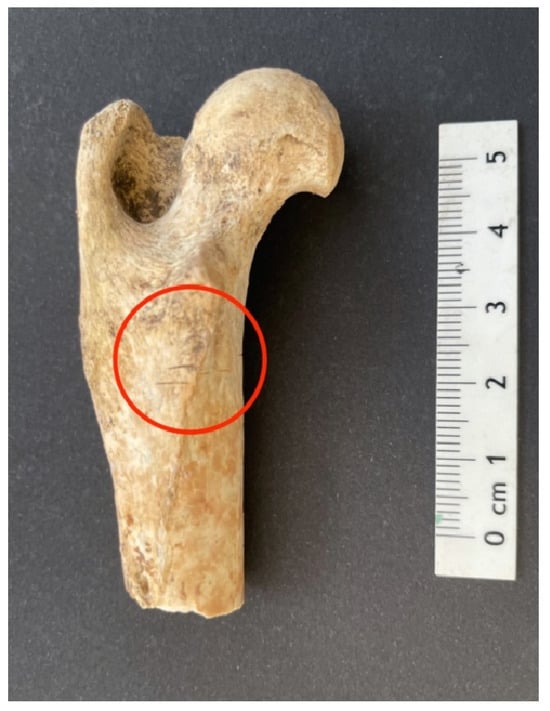
Figure 3.
Canis familiaris proximal femur distal tibia (caudal view, left side) with butchering slice marks immediately distal to the lesser trochanter made by a metal tool (TZ 017194-010) from Late Bronze Age II at Tell Zirāʿa (Stratum 14c.d). Scale is in mm. The red circle is showing the location of the butchering slice mark discussed in the text.
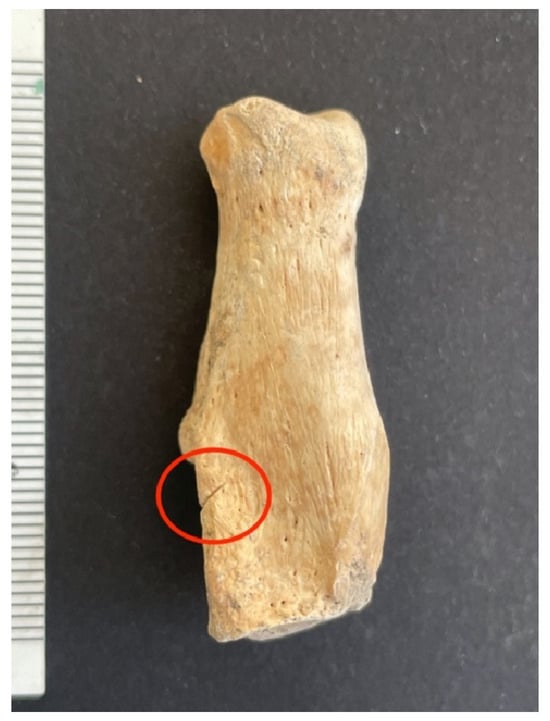
Figure 4.
Canis familiaris calcaneus (lateral view, left side) with butchering slice mark in the middle of the distal half made by a metal tool (TZ 017181-001) from Late Bronze Age II at Tell Zirāʿa (Stratum 14). Scale is in mm. The red circle is showing the location of the butchering slice mark discussed in the text.
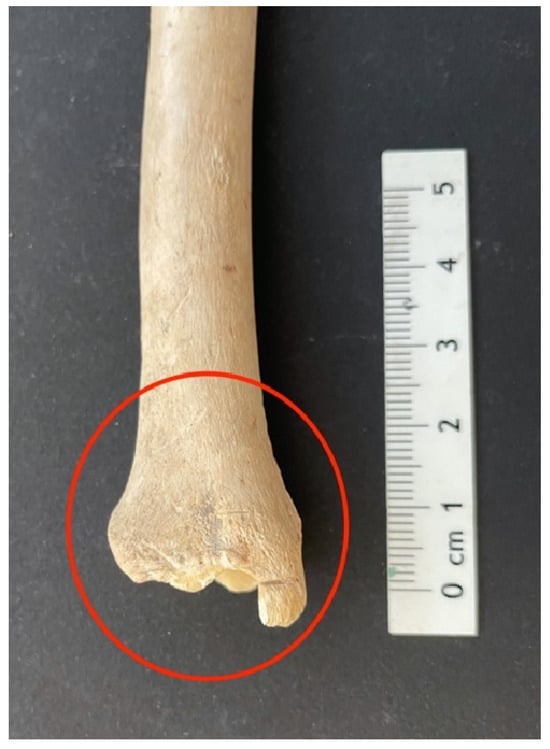
Figure 5.
Canis familiaris distal tibia (cranial view, right side) with butchering slice marks on the medial malleolus made by a metal tool (TZ 010439-001) from Iron Age II A/B (Stratum 12) at Tell Zirāʿa. There were eight microscopically visible slices on the distal end to disarticulate the tibia from the tarsal bones. Under the microscope, eight slices are visible, while only three or four are visible to the naked eye. Scale is in mm. The red circle is showing the location of the butchering slice mark discussed in the text.
4.11. Side Preference
When the data on the side of the body are tabulated for all dog osteological elements (and the unknown side of elements are not included), there does not seem to be a particular emphasis upon either right- or left-sided limbs (NISP 20 left-sided versus 17 right-sided individuals—Table 10). When only butchered specimens are considered, the same pattern appears (7 left versus 5 right). In other words, there is no preference for the right or left side.

Table 10.
Frequency distribution of all and butchered Canis familiaris osteological remains by time period and side of the body (symmetry) from Tell Zirāʿa (Stratum 14). (NISP—Number of identified specimens). Bold numbers are for sums of each time period.
However, there are differences between time periods, as there is a difference between the Bronze and Iron Ages when all dog bones are considered. Even though the sample is very small, there is a seeming preference for left over right in the Early, Middle, and Late Bronze Ages—15 left versus 3 right. But this changes in the Iron Age when there are more right-sided individuals—7 left versus 14 right. When only the butchered dog bones are considered, the Bronze Age strata contain 5 left-sided and 0 right-sided individuals. By contrast, the Iron Age strata contains 2 left and 5 right. In other words, the same shift in preference is seen in both the general and butchered dog assemblage regardless of time period. The reason for this shift is not clear at the moment and must await comparable studies to determine if this is a behavioural choice (e.g., preference) or simply a random outcome of multiple factors.
5. Depositional Context of Butchered Remains
In this section, each of the deposits associated with butchered dog bones from the Late Bronze Age I to Iron Age II strata are described to understand their significance (or lack thereof). Our focus is on the last Late Bronze Age and Iron Age strata, Late Bronze Age Stratum 16 (Table 11), Late Bronze Age Stratum 14 (Table 12), Iron Age I Stratum 13 (Table 13), and Iron Age II Stratum 12 (Table 14), as these data elements are the most relevant to the issue under consideration. Details of all contexts can be seen in the final excavation reports, which are available for download at https://www.tallziraa.de (accessed on 19 April 2024).
5.1. Stratum 16 (Late Bronze Age I)
Even though only a small part of this stratum has been excavated so far, the architecture found (courtyard houses) as well as pottery, small finds, and C14 samples indicate that this stratum represents a settlement phase in the transition from the Middle Age to the Late Bronze Age I. All three dog bones (a humerus, femur, and calcaneus, all from adult individuals) with butchering marks were found in one context (Complex B—See Table 10 for osteological and analytical descriptions). All were butchered with metal knives.

Table 11.
Butchered Canis familiaris bones from Stratum 16 at Tell Zirāʿa.
Table 11.
Butchered Canis familiaris bones from Stratum 16 at Tell Zirāʿa.
| TZ Find Number | Context | Square | Complex | Bone Element | Age Class | Butcher Type | Function |
|---|---|---|---|---|---|---|---|
| 019423-001 | 6311 | AT 122 | B | Humerus | Adult | 2 slices; metal knife | Disarticulation |
| 019423-002 | 6311 | AT 122 | B | Femur | Adult | 1 slice; metal knife | Disarticulation |
| 019423-003 | 6311 | AT 122 | B | Calcaneus | Adult | 1 chop; metal axe | Dismemberment |
Complex B consists of nine (B 1–9) rooms and a courtyard. The walls all have an approximately equal thickness of 60 cm and often tie into each other. One exception is Wall 6418, which is twice as wide and separates Complex B from Complex A. The sizes of the rooms vary between 4 and 10.5 m2. It is possible that Complex B’s various rooms (B 1, 2, 3, 5, 6, and 8, as well as B 7, 9, and 10) belong to a few closely related living areas.
B 1 refers to a courtyard area. Room B 2 adjoins B 1 to the south and is bounded by Walls 6417, 6321, 6055, and 6145. Remains of Pavement 6447 are preserved within the room and correspond in height to remains of Pavement 6318 in Courtyard B 1. The associated fill layer is feature 6311. It is in this context that the butchered dog bones (a humerus, femur, and calcaneus) were found (Figure 6; Table 11).
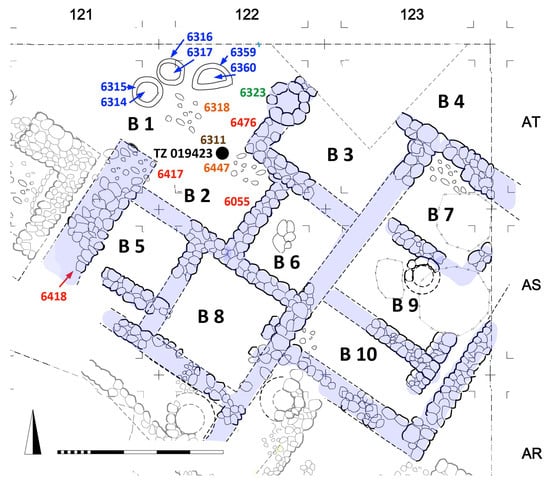
Figure 6.
Plan of Complex B, Stratum 16, at Tell Zirāʿa. The find spot of the butchered Canis familiaris bone is marked by a black circle on the plan. Size of every square is 5 m × 5 m in all figures. Red = wall; blue = oven/fireplace; green = pit; orange = pavement; brown = fill layer.
Context 6311 also contains the following finds, among others: rubbing stones and a stone lid; copper needles or awls; fragment of a copper axe or dagger blade; fragment of an earring; five iron nodules, charcoal and olive pits, flint object, and oval clay loom weight; ceramic token; glass bead; shells and snails, bones of cattle (N = 18), sheep, and goats (N = 83), and a gazelle horn (TZ 019312-001 [48]). It is not known if the bones of the sheep and goats were butchered. The courtyard was used for food preparation.
5.2. Stratum 14 (Late Bronze Age II)
Of the 11 dog bones in Stratum 14 (LB II), only three displayed evidence of butchering (Table 12—a humerus, femur, and calcaneus). They ranged in age from subadult (femur) to subadult/adult (humerus) to adult (calcaneus). None were burned or display any other evidence of cooking, although their disarticulated nature suggests that they were consumed. All were butchered with metal knives.

Table 12.
Frequency distribution of butchered dog bones from Late Bronze Age II (Stratum 14) at Tell Zirāʿa.
Table 12.
Frequency distribution of butchered dog bones from Late Bronze Age II (Stratum 14) at Tell Zirāʿa.
| TZ Find Number | Stratum | Context | Square | Complex | Bone Element | Age Class | Butcher Type | Function |
|---|---|---|---|---|---|---|---|---|
| 017181-001 | 14a | 5520 (floor level) | AP 121 | D | Calcaneus | Adult (middle) | 1 slice, metal knife | Disarticulation |
| 017194-001 | 14c-d | 5555 (inside silo) | AF 115 | L | Femur | Subadult (old) | 6 slices, metal knife | Filleting |
| 017194-002 | 14c-d | 5555 (inside silo) | AF 115 | L | Humerus | Subadult/ | 3 slices, metal knife | Filleting |
| Adult |
In the latest Late Bronze Age II deposit (Stratum 14a), there was only a single butchered dog bone—a calcaneus (TZ 017181-001—Table 12; Figure 4). It comes from the beaten earth floor level southeast of the large temple (Complex D) that dates to the LB II (Figure 7). Even though much of the area is heavily disturbed by Iron Age pits, this bone could be assigned to the layer directly above the pavement of the forecourt that was not impacted by Iron Age pits. While other evidence of food preparation in the courtyard is lacking (e.g., there is no cooking area), the presence of bowls and cooking pots found at this location suggests food preparation and consumption.
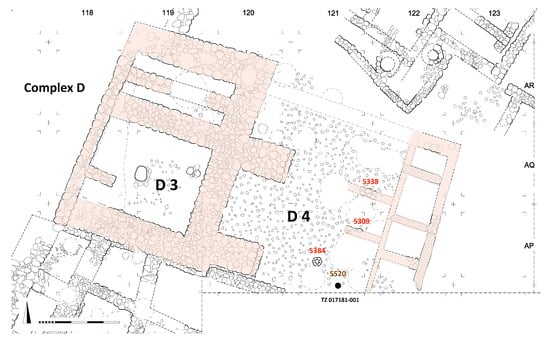
Figure 7.
Plan of Complex D, Stratum 14a, at Tell Zirāʿa. Find spot of the butchered Canis familiaris bone is marked by a black circle on the plan. Red = wall; brown = fill layer.
Room D 4 denotes the paved courtyard in front of Complex D (Figure 7). It is bounded on the west by the temple in antis and on the east by a series of four small rooms. The southern boundary is unclear as it lies outside the excavation area. The northern boundary can only be determined based on the absence of architectural (negative) finds, since the stones were robbed here in Classical times. The courtyard covers an area of about 10 m × 10 m and is very elaborately paved with small field stones. Two intermediate walls project into the courtyard from the four eastern buildings (Contexts 5338 and 5309). Context 5384, in the southern area of the courtyard, is an accumulation of 6 fieldstones laid out in a ring (clay was found inside the ring, but without any finds), possibly forming a posthole.
Context 5520, adjacent to this posthole, contained the butchered dog calcaneus bone (Figure 8), as well as other animal bones (NISP 54; most were sheep or goat bones, eight were cattle bones, and one was a dog bone [48]). In addition, there were a miniature ceramic vessel (TZ 020820-001 and TZ 020820-002; Figure 9), a fragment of a ceramic chalice, and possibly a fragment of a ceramic snake appliqué from a cultic stand (TZ 020820-009; Figure 10). See comparative pieces from Hazor and Beth Shean [60]. The ceramic assemblage was mainly composed of bowls, but also some jugs and cooking pots.
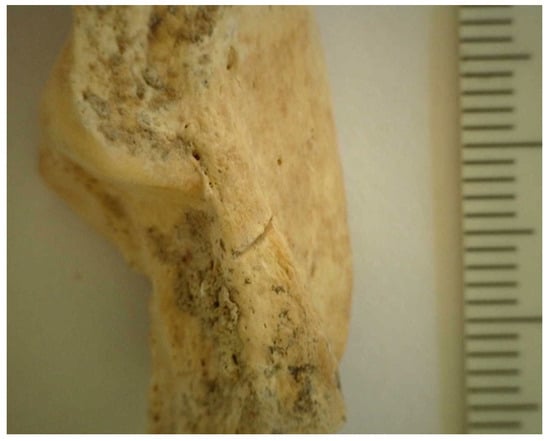
Figure 8.
Close-up photo of a butchering slice mark on a Canis familiaris calcaneus (TZ 017181-001) from Late Bronze Age II Stratum 14 at Tell Zirāʿa. See Figure 4 for general photograph of specimen. Scale is in mm.
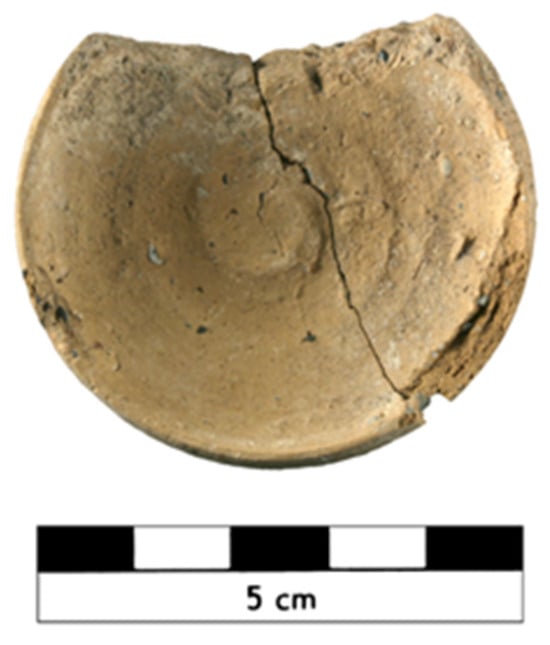
Figure 9.
Miniature vessel TZ 020820-001 and -002 from Late Bronze Age II Stratum 14 at Tell Zirāʿa.
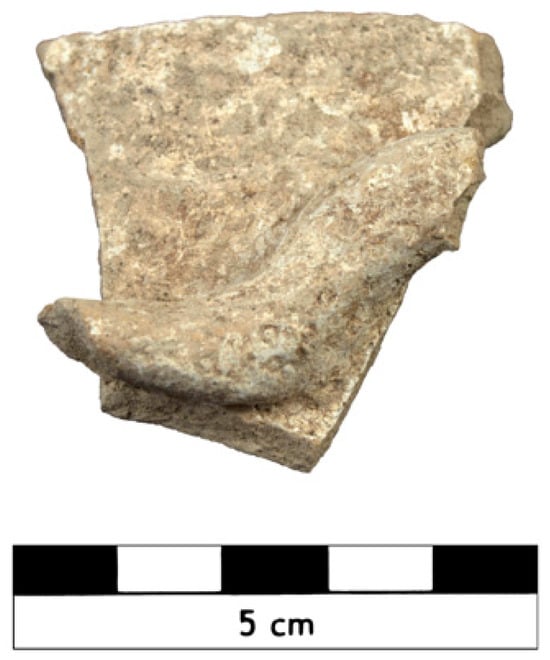
Figure 10.
Fragment of a snake appliqué of a cultic stand TZ 020820-009 from Late Bronze Age II Stratum 14 at Tell Zirāʿa.
The other two dog bones (femur and humerus) from Late Bronze Age II Stratum 14 (Table 12; TZ 017194-001/Figure 3 and TZ 017194-002) come from an earlier phase of the Late Bronze Age found in Complex L, a courtyard house in the south of Area I (Figure 11). An area of c. 10 m × 8 m was excavated and consists mostly of a large and paved courtyard of c. 45 m2 (L 2).
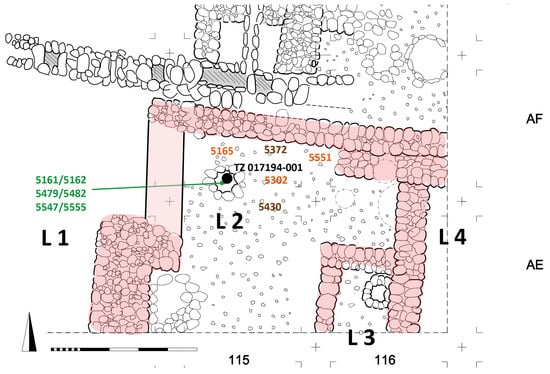
Figure 11.
Late Bronze Age II Complex L Stratum 14d with find spot of butchered Canis familiaris bone TZ 017194-001 at Tell Zirāʿa. The find spot for the butchered Canis familiaris bone is marked by a black circle on the plan. Green = pit; orange = pavement; brown = fill layer.
The large courtyard L 2 is completely paved and contains two storage silos. Context 5555 is the floor/last fill layer of the northern silo. This consists of a ring of 40–50 cm fieldstones. Finds included in its assemblage are: flint objects, rubbing stones, and a pedestaled stone bowl; and an almost completely preserved jug, shell pendants, game pieces, a fragment of an awl, and various ceramic vessels. In addition, there were animal bones (NISP 60; 15 cattle, 38 sheep or goat, 5 domestic pig, and two dog bones; see [48]). The two dog bones are described above.
5.3. Stratum 13 (Iron Age I)
Of the 18 dog bones in Stratum 13, only three dog bones display any evidence of butchering and none were burned. Their disarticulated nature suggests that they were consumed (Table 13). They include a humerus, innominate, and humerus, and all were from adult individuals. All were butchered with metal knives.

Table 13.
Butchered Canis familiaris bones from Iron Age I Stratum 13 at Tell Zirāʿa. Find TZ 011579-001 may also be Iron Age II A/B as it was a mixed fill layer that could not be assigned with 100% certainty to this stratum and may also be from Stratum 12.
Table 13.
Butchered Canis familiaris bones from Iron Age I Stratum 13 at Tell Zirāʿa. Find TZ 011579-001 may also be Iron Age II A/B as it was a mixed fill layer that could not be assigned with 100% certainty to this stratum and may also be from Stratum 12.
| TZ Find Number | Context | Square | Complex | Bone Element | Age Class | Butcher Type | Function |
|---|---|---|---|---|---|---|---|
| 010521-001 | 2831 | AG/AH 116 | H | Calcaneus | Adult | 4 slices; metal knife | Disarticulation to separate tibia from tarsals |
| 011579-001 | 3376 | AI 117 | H | Innominate (ilium) | Adult | 8 scrapes; metal knife | Filleting |
| 017886-001 | 5895 | AU 120 | A | Humerus | Adult (young) | 1 slice; metal knife | Disarticulation; Separate humerus from radius |
One of the dog bones (TZ 017886-001—humerus) with butchering marks comes from the Iron Age I Complex A or the surrounding area (Table 13; Figure 12). The complex occupies almost the entire northern area of Area I and lies in the Squares AT-AS 120-123, AR 122-123, and AQ 123, as well as in parts of AU 120, AR 121, and AQ 122.
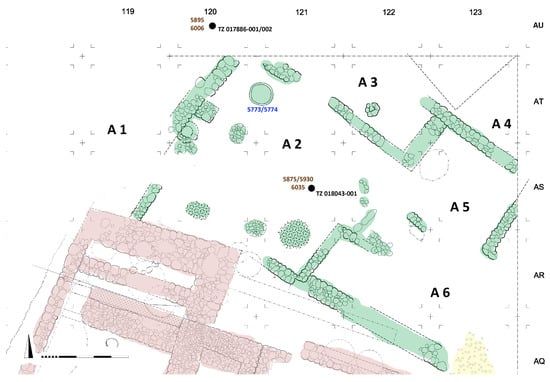
Figure 12.
Iron Age I Complex A, Stratum 13, with find spots of Canis familiaris bones at Tell Zirāʿa. Find spots for each of the butchered Canis familiaris bones are marked by black circles on the plan. Blue = oven/fireplace; brown = fill layer.
The area was heavily disturbed by the later Classical strata, so that only rudimentary remains of architecture were found. What is striking about all of the finds from this complex is the almost complete absence of imported pottery or fine wares. Room A 2 (courtyard) seems to have been a food preparation area because many objects for preparing food were found there.
Area A 1 denotes the fill layers (without architectural features) west of the outer wall. The fill layer (Context 5895, with both dog bones TZ 017886-001 and -002; one with butcher marks on its distal end [humerus] and one without any butchering marks [a vertebra]) is located in Square AU 120 and contained a rubbing stone, a bolt/wedge, three flint objects, animal bones (NISP 17; of these, five were cattle bones, two were dog bones, and the rest were sheep or goat bones [48]), as well as ceramic vessels (almost exclusively closed vessels). A statement on the function of the context is not possible due to the lack of architecture.
Room A 2 comprises an almost square area measuring ca. 10 m × 10 m. The interior is devoid of any architecture, even though it contains a few pits and a large oven (Context 5773/5774) with a diameter of ca. 1.30 m. The interior of the oven was used as a fireplace. Inside the kiln, there was a smashed cooking vessel. The stratified clay and ash layers were clearly visible in the profile of the oven.
Two other fill layers in the interior of this room (A 2) contained dog bones, albeit without marks:
- Context 5875: animal bones (NISP 70), of which 11 are cattle bones, 3 are horse/donkey/mule bones, 1 is a domestic pig bone, 1 is a dog bone (a cervical vertebra), 1 is a wild sheep bone, and the rest are sheep or goat bones [48]. There is also some iron casting residue and a fragment of a bronze needle.
- Context 6035: animal bones (NISP 30), of which seven are cattle bones, one is a domestic pig bone, and one is a dog lumbar vertebra (TZ 018043-001), otherwise the rest are sheep or goat bones [48]. There are also sherds of cooking pots, a pilgrim flask, a spindle whorl, as well as one flint object.
Complex H from Iron Age I (Stratum 13) appears to be a courtyard house, only a small part of which has been excavated (Figure 13). It comprises Squares AH 116/AI 117 as well as parts of Squares AG 116, AI 116, and AK 117. A corridor separates the complex from the neighbouring complexes F (in the north) and G (in the west). It is detached from the surrounding buildings on three sides, which is a special feature, since buildings are usually structurally connected to their surroundings on at least one side. The eastern half has not yet been excavated.
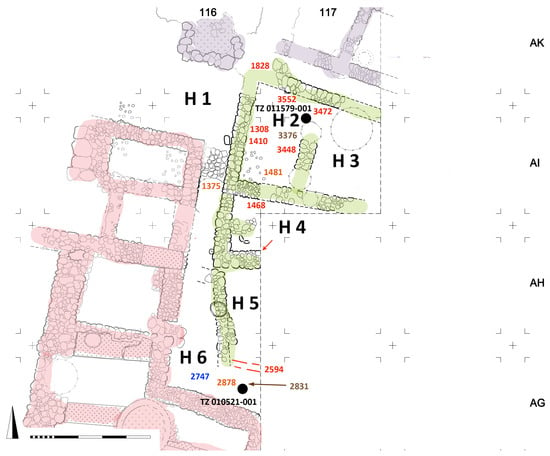
Figure 13.
Iron Age I Complex H with find spots of butchered Canis familiaris bones from Stratum 13 at Tell Zirāʿa. Find spots for the butchered Canis familiaris bone are marked by black circles on the plan. Red = wall; blue = oven/fireplace; orange = pavement; brown = fill layer.
Room H 2 seems to have been a storage room given the large number of storage vessels and the almost complete absence of stone or metal artefacts. Room H 2 is bounded by Walls 1828, 3552, and 3472 to the north; 3448 to the east; 1468 to the south; and 1308/1410 to the west. Remains of Pavement 1481 are preserved in the southwest. The fill in Room H 2 (Context 3376, dog bone TZ 011579-001—an adult innominate [ilium]) could not be clearly assigned to the stratum above (Stratum 12) or below (Stratum 13).
The long L-shaped Corridor H 6, where dog bone TZ 010521-001(an adult calcaneus; Table 13) was found, has a width of 0.80–1.00 m. It begins in H 1, then runs to the south and extends for 8 m between Complexes G and H, and then finally bends eastwards along Complex H for a further 3 m to the end of the excavation area. It seems to have been originally partly paved, as there are paving remains to the north (Context 1375), and partly paved with a lime floor in the south (Context 2878).
5.4. Stratum 12 (Iron Age IIA/B)
There were only five dog bones in Iron Age II Stratum 12, four of which were butchered (scapula, humerus, tibia, and calcaneus) and one was burned (radius). They were clearly consumed (Table 14). They include a range of osteological elements from both fore and hind limbs (scapula, humerus, tibia, and astragalus). All were butchered with metal knives.

Table 14.
Information on butchered Canis familiaris bones from Iron Age II A/B Stratum 12 at Tell Zirāʿa.
Table 14.
Information on butchered Canis familiaris bones from Iron Age II A/B Stratum 12 at Tell Zirāʿa.
| TZ Find Number | Context | Square | Complex | Bone Element | Age Class | Butcher Type | Function |
|---|---|---|---|---|---|---|---|
| 008943-001 | 2104 | AN 119 | D | Radius | Adult | Cooked | |
| 009695-001 | 2600 | AG/AH 116 | F | Scapula | Juvenile | 19 slices; metal knife | Filleting |
| 010439-001 | 2793 | AH 116 | F | Tibia | Adult | 8 slices; metal knife; light rodent gnawing | Disarticulation; separate tibia from tarsals |
| 011186-001 | 3224 | AE 116 | G | Astragalus | Subadult/adult | 3 slices; metal knife | Disarticulation; separate tarsal from metatarsal |
| 017153-001 | 5466 | AS 123 | A | Humerus | Adult (middle) | 21 slices, metal knife | Disarticulation; Separate humerus from radius |
The extensive Iron Age II Complex A contained a dog bone (humerus) with 21 slices (TZ 017153-001; Table 14). Even though the development of Stratum 12 differs in essential points from the development of Stratum 13, the complex or site boundaries remain unchanged.
Complex A, which is similar to Complex A in Stratum 13, occupies almost the entire northern area: Squares AR-AT 119-123 as well as parts of Squares AR 118 and AU 120 (Figure 14). The area was heavily disturbed by later Classical period constructions, so that only rudimentary remains of architecture were found.
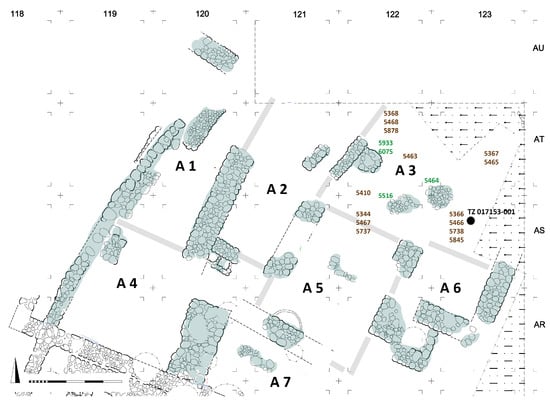
Figure 14.
Iron Age II Complex A, Stratum 12, with find spot of butchered Canis familiaris bones at Tell Zirāʿa. The find spot for the butchered Canis familiaris bone is marked by a black circle on the plan. Green = pit; brown = fill layer.
The surviving walls are more massive than in the Iron I stratum and suggest increased residential stability, status/wealth, or an increased need for security on the part of the inhabitants. The more massive walls definitely point to the presence of higher and larger buildings. The high proportion of storage vessels suggests that Room A 1 (especially the southern part) was a storage room. The pottery within Room A 3 seems to indicate a storage, waste, and cooking area—the ceramics consist almost exclusively of closed vessels and cooking pots.
The cooked dog bone (radius) comes from Complex D (Figure 15), a four-room house, from the courtyard area (TZ 008943-001; Table 14), where food was prepared.
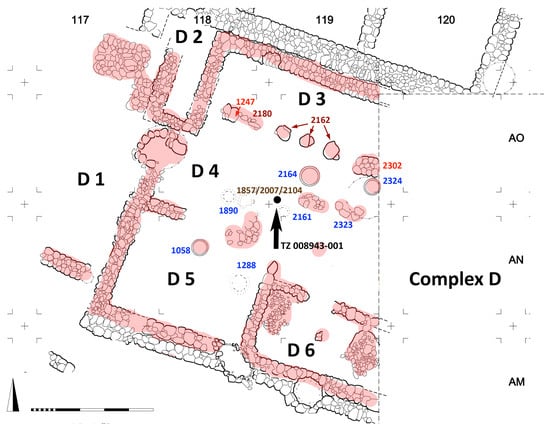
Figure 15.
Complex D, Stratum 12, with find spot of butchered Canis familiaris bone at Tell Zirāʿa. The find spot for the butchered Canis familiaris bone is marked by a black circle on the plan. Red = wall; blue = oven/fireplace; brown = fill layer.
Complex D comprises Squares AM-AO 117–119 as well as parts of AP 117–119 and extends over an area of c. 13 m × 15 m, although the end of the eastern extension has not yet been reached (Figure 15). Much more clearly than in Stratum 13, individual rooms associated with the complex can be identified in Stratum 12—namely four in the interior (D 3 to D 6) and two in front in the west (rooms D 1 and D 2). The preserved interior of the complex shows a rough division into three parts from north to south. In the north, the rectangular elongated Room D 3 is separated from Room D 4 by small intermediate Walls 1247 and 2302 as well as individual stones/column bases 2162 and 2180. In the south, the two smaller rooms (D 5 and D 6) are separated from D 4 by intermediate walls.
The central space within the complex is likely a courtyard (D 4). It seems to have been paved and contains several hearths/tabuns (marked in blue). Fill layers in Square AN 119 contained pottery, consisting of cooking ware as well as storage vessels, and the function seems to have been preparation of food. The burned dog bone TZ 008943-001 (radius) stems from Context 2104.
Two dog bones come from Iron Age II Complex F (scapula and tibia) and one from the adjacent Complex G to the south (astragalus; Table 14; Figure 16). Both complexes cannot be clearly separated and could also have belonged to one building.
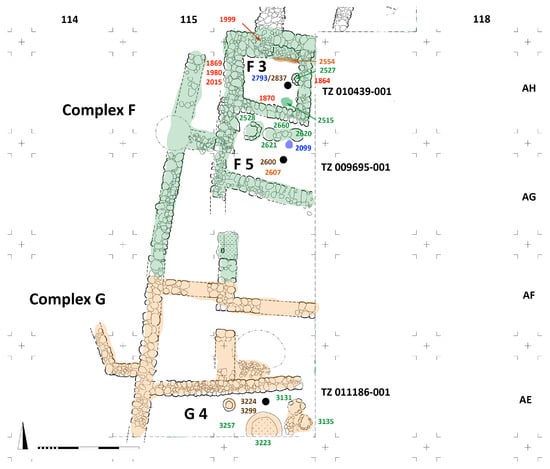
Figure 16.
Iron Age II Complexes F and G, Stratum 12, with find spots of butchered Canis familiaris bones at Tell Zirāʿa. The find spots of the each of the butchered Canis familiaris bones are marked by black circles on the plan. Red = wall; blue = oven/fireplace; green = pit; orange = pavement; brown = fill layer.
In Complex F, the almost square room F 3 is formed by Walls 1999 in the north, 1864 in the east, 1870 in the south, and 1869/1980/2015 in the west (Figure 16). Attached to the eastern wall is a silo (2527) with a diameter of 50 cm. The ash pit (2515) in the south-east of the room contained the fragment of an inscribed stamp seal in faience (TZ 009464-001). Remains of a cobble floor (2554) are still preserved in the north of the room. Feature 2793 denotes another ash pit/possibly hearth, in which the dog bone (TZ 010439-001; tibia) was found (Figure 5).
In Room F 5, adjacent to and south of Room F 3, dog bone TZ 009695-001 (scapula; Table 13) was found. Within the room were found several pits that may also have been silos (Pits 2528, 2620, 2621, and 2660), as well as an oven (Tabun 2099). Finds within the pits indicate a crafting area. Among the finds were a rubbing plate, several rubbing stones, two stone bowls, a weight and two querns, a fragment of a melting pot made of limestone, two flint objects, metal fragments and raw material remains, a ceramic funnel, and tabun fragments.
Dog bone specimen TZ 011186-001 (astragalus) comes from room G 4, the southernmost room, which has only been partially excavated. The eastern part of the room, east of a column base, was used for storage and contains pits/silos (Pits 3131 and 3135 and Silo 3223).
6. Ritual Context?
While there is only a single, known find of a dog figurine (from Ekron) [5], there are several examples of dog burials and sacrifices in the southern Levant [27]. Are these related to the consumption of dogs? Do these customs suggest a non-indigenous population? The question arises whether dogs in the southern Levant (apart from their useful aspects) perhaps also had a religious, cultic function.
There are no examples from the Early or Late Bronze Age of adult or puppy burials. There is only a single site from the Middle Bronze Age with a seeming ritual internment of a dog skeleton—the temple at Tel Haror [27].
To date, the only dog burials from the Iron Age I period are found in the Philistine heartland, in the southern coastal plain [6]. All of these burials of dogs (or parts of dogs) come from ritual contexts: from near a cultic installation on Tel Miqne-Ekron [35], buried in vessels in Ashkelon [11], or in a separate room in Ashdod [36]. As the origins of these burials remain open (even though there is some evidence of an Aegean origin—[even though there is some evidence for an Aegean origin] [33]), the question remains whether this is an indigenous or an imported ritual practice. Given the prevalence of dog burials outside the southern Levant, such as from ancient Greece, this may seem likely [6].
Adult and puppy dog burials, which have a clear ritual significance, begin to appear in the southern Levant during Iron Age I at sites associated with the Philistines. During excavations at Philistine Ashkelon, five Iron Age I puppy burials were found in pots. Analysis of these remains interpreted them as foundation offerings or foundation deposits. They have slice marks suggesting skinning but do not appear to have been consumed. Two burials from Ashdod are known from Iron Age II (although one seems to be more likely from the Persian period, and one was buried in an Aegean cooking jar) [5,27].
At Tel Miqne, a puppy was buried with its severed head between its hind legs (Stratum VIB, Field INE, Iron Age I, Locus 36052) and an ivory knife handle lay beside it. The context suggests an unroofed, industrial courtyard area. Similar ritual sacrifices of dogs are known from the Hittite area [27,61]. Hittite texts describe puppies being split in two and a person passing between the parts to be purified or to avert a bad omen [27]. A similar ritual is described by Quintus Curtius Rufus, Titus Livius, and Hesychius for the Roman and Macedonian army [62].
The biblical texts, on the other hand, always speak of dogs as unclean animals, not fit for consumption or sacrifice. In Gen 15:7-21, sacrificial animals are described as being divided into two parts. But in this text, it is the divine presence that passes between the parts and not the sacrifice [27]. Is this, then, possibly a western Anatolian rite transplanted by the Philistines to the southern Levant—namely the cutting into two parts and careful burial of a whelp as part of the ritual activities—that has somehow crept into the biblical text [27]? It would appear to be far-fetched to attribute the biblical text to Philistine origins.
As noted earlier, dog sacrifices are not limited to the eastern Mediterranean. In Bronze and Iron Age Italy, dog burials have been identified as sacrifices as well as foundation offerings for buildings and grave goods (as an addition to a human burial). Since dogs are also associated with the underworld and death in ancient mythology (especially Greek), their addition to burials can be interpreted as part of a rite of passage to the underworld.
7. Conclusions—Dog Consumption as a “Cultural Marker”?
In this paper, we reviewed the evidence of dog butchering as evidence of Philistine dog consumption and how it might relate to the butchering patterns at the site of Tell Zirāʿa. It is clear that dog butchery (and by implication, consumption) is an extremely small fraction of the overall zooarchaeological assemblage at Tell Zirāʿa. There were only 10 dog bones with butchering marks from the EB II/III to LB II deposits at the site, while there were 8 butchered dog bones from the Iron I and II deposits. While the 10 Bronze Age bones may be divided over an 1800-year time span (=0.56/century), the 8 Iron Age bones would be divided over a 600-year time span (=1.33/century). Clearly, the intensity of dog consumption increases in the Iron Age. Even though the data are small, the scale of dog consumption appears to increase over time.
As noted by Maeir et al. 2013 [33], “There is some evidence for the consumption of dog flesh in Late Bronze–Iron Age sites in the Aegean and it is possible, although the current Levantine data are equivocal, that this practice was introduced into Philistia from the Aegean.” This is a very different conclusion than that reached by Maher [5]—“Prior evidence for dog consumption as an indigenous Levantine tradition is generally lacking.”. While Maher [5] notes some evidence of Bronze Age examples (e.g., at Tel Haror and Lachish), the data from Tell Zirā’a suggest a general continuity in consumption patterns between the Bronze and Iron Ages. Most certainly, there is more than a doubling of the rate of consumption of dogs with the advent of the Iron Age, yet the overall frequency of dog consumption remains extremely low and quantitatively insignificant. In other words, dog butchering/consumption cannot be used as a marker of Philistine ethnic behaviour. We can see the shift in consumption pattern with the advent of the Iron Age, but it is only one component of a complex cultural identity. Dog consumption is a very minor part of the assemblage, and most certainly not found in all sites or in all parts of sites during the Iron Age. Furthermore, it is interesting to observe that most of the Tell Zirāʿa canid finds come from residential development and cannot be assigned to any ritual context.
The butchered dog bones from Tell Zirā’a can clearly be considered domestic consumption. As was also demonstrated, the depositional contexts for each of the butchered dog bones is from domestic contexts—all found in and around houses. Furthermore, the presence of dog bones mixed in with more clearly food remains from a larger faunal assemblage (e.g., sheep, goats, cattle, pigs) suggests that dogs were consumed in a similar manner as other species.
Based on the data from Tell Zirāʿa, the consumption of dogs does not represent an innovation of the Iron Age (and thus of possible immigrants). Nevertheless, it increased from the end of the Late Bronze Age to the end of Iron Age II A/B. Therefore, the assumption that eating dog only occurs among the Philistines cannot be substantiated. But, the increased occurrence of dogs in the Iron Age further suggests the influence of new and non-indigenous immigrants to the southern Levant. The most likely are those who had an Aegean or Anatolian background where such practices were present during the preceding periods, such as the Philistines.
In conclusion, while it has been argued that the increase in consumption of dogs in the southern Levant during the Iron Age was due to the advent of the Philistines/“Sea Peoples” into the region, comparison of the quantity of dog bones (and particularly butchered bones) identified from both Bronze and Iron Age urban sites in the southern Levant thus far is not an adequate marker of their presence at sites in and of itself. There is some support for association with new migrants, such as the Philistines, in that the quantity of dog butchered remains more than doubles. But, it should not be used in isolation as a marker, but only as part of a larger constellation of remains. As Maeir [63,64] and others have long noted and long advocated [34,65,66,67,68], identity is a complex affair and may be signaled by food as well as a host of other behaviours. To assume that a single behaviour is characteristic of a people and their identity is naïve at best. The situation is clearly more complicated!
Author Contributions
All steps of this article were done together. Conceptualization, K.S. and H.J.G. methodology, K.S. and H.J.G.; validation, K.S. and H.J.G.; formal analysis, K.S. and H.J.G.; investigation, K.S. and H.J.G.; resources, K.S. and H.J.G.; data curation, K.S. and H.J.G.; writing—original draft preparation, K.S. and H.J.G.; writing—review and editing, K.S. and H.J.G.; visualization, K.S. and H.J.G.; project administration, K.S. and H.J.G.; funding acquisition, K.S. and H.J.G. All authors have read and agreed to the published version of the manuscript.
Funding
This research was funded by the Social Sciences and Humanities Research Council of Canada, The University of Manitoba, and St. Paul’s College of the University of Manitoba.
Institutional Review Board Statement
Not applicable.
Informed Consent Statement
Not applicable.
Data Availability Statement
Excavation reports are downloadable from https://www.tallziraa.de/Final-publication/1_470.html (accessed on 24 March 2024).
Acknowledgments
The authors would like to thank the German Protestant Institute for Archaeology hosting and for arranging access to the material used in this study. In particular, we are deeply appreciative of the support extended to us by the various directors of the excavations—Dieter Vieweger, Jutta Häser, and Katharina Schmidt. Finally, we sincerely thank Jill Katz and Ed Maher for their very thoughtful comments on a draft of the manuscript. We extend our deepest appreciation to the three anonymous and independent referees for their constructive critical comments on earlier versions of the manuscript.
Conflicts of Interest
The authors declare no conflict of interest.
References
- Dayan, T. Early domesticated dogs of the Near East. J. Archaeol. Sci. 1994, 21, 633–640. [Google Scholar] [CrossRef]
- Germonpré, M.; Van den Broeck, M.; Lázničková-Galetová, M.; Sablin, M.V.; Bocherens, H. Mothering the orphaned pup: The beginning of a domestication process in the Upper Palaeolithic. Hum. Ecol. 2021, 49, 677–689. [Google Scholar] [CrossRef]
- Ovodov, N.D.; Crockford, S.J.; Kuzmin, Y.V.; Higham, T.F.G.; Hodgins, G.W.L.; van der Plicht, J. A 33,000-Year-Old Incipient Dog from the Altai Mountains of Siberia: Evidence of the earliest domestication disrupted by the last glacial maximum. PLoS ONE 2011, 6, e22821. [Google Scholar] [CrossRef] [PubMed]
- Verginelli, F.; Capelli, C.; Coia, V.; Musiani, M.; Falchetti, M.; Ottini, L.; Palmirotta, R.; Tagliacozzo, A.; Mazzorin, I.G.; Mariani-Costantini, R. The origin of dogs: Archaeozoology, genetics and ancient DNA. Med. Secoli 2006, 18, 741–754. [Google Scholar]
- Maher, E.F. Flair of the dog: The Philistine consumption of canines. In The Wide Lens in Archaeology: Honoring Brian Hesse’s Contributions to Anthropological Archaeology; Lev-Tov, J., Hesse, P., Gilbert, A., Eds.; Lockwood Press: Atlanta, GA, USA, 2017; pp. 117–147. [Google Scholar]
- Snyder, L.M.; Klippel, W.E. From Lerna to Kastro: Further thoughts on dogs as food in ancient Greece; perceptions, prejudices and reinvestigations. In Zooarchaeology in Greece: Recent Advances; Kotjabopoulou, E., Hamilakis, Y., Halstead, P., Gamble, C., Elefanti, P., Eds.; British School at Athens: London, UK, 2003; pp. 221–231. [Google Scholar]
- Greenfield, H.J. (Ed.) Animal Secondary Products: Domestic Animal Exploitation in Prehistoric Europe, the Near East and the Far East; Oxbow Press: Oxford, UK, 2014. [Google Scholar]
- Shipman, P. And the last shall be first. In Animal Secondary Products: Domestic Animal Exploitation in Prehistoric Europe, the Near East and the Far East; Greenfield, H.J., Ed.; Oxbow Press: Oxford, UK, 2014; pp. 40–55. [Google Scholar]
- Shipman, P. The Invaders: How Humans and their Dogs Drove Neanderthals to Extinction; Harvard University Press: Cambridge, MA, USA, 2015. [Google Scholar]
- Price, M.D.; Meier, J.; Arbuckle, B. Canine economies of the ancient Near East and eastern Mediterranean. J. Field Archaelogy 2021, 46, 81–92. [Google Scholar] [CrossRef]
- Stager, L.E.; Schloen, J.D.; Master, D.M.; Press, M.D.; Aja, A. Stratigraphic overview. In Ashkelon 1: Introduction and Overview (1985–2006); Stager, L.E., Schloen, J.D., Master, D.M., Eds.; Eisenbrauns: Winona Lake, IN, USA, 2008; Volume 1, pp. 212–323. [Google Scholar]
- Black, E.W. Ritual dog burials from Roman sites. Kent Archaeol. Rev. 1983, 71, 20–23. [Google Scholar]
- Clutton-Brock, J. Ritual burials of a dog and six domestic donkeys. In Nagar in the Third Millennium BC: Excavations at Tell Brak 2; Oates, D., Oates, J., McDonald, H., Eds.; McDonald Institute, University of Cambridge: Cambridge, MA, USA, 2001; pp. 327–338. [Google Scholar]
- Collins, B.J. The puppy in Hittite ritual. Orient. Inst. News Notes 1992, 136, 1–6. [Google Scholar] [CrossRef]
- Neer, W.V.; Linseele, V.; Friedman, R. More animal burials from the Predynastic elite cemetery of Hierakonpolis (Upper Egypt): The 2008 season. Archaeozool. Near East 2017, 9, 388–403. [Google Scholar]
- Vuković, S.; Jovičić, M.; Marković, D.; Bogdanović, I. Sacrificing dogs in the late Roman World? A case study of a multiple dog burial from Viminacium amphitheatre. In Roman Animals in Ritual and Funerary Contexts: Proceedings of the 2nd Meeting of the Zooarchaeology of the Roman Period Working Group, Basel, Switzerland, 1–4 February 2018; Deschler-Erb, S., Albarella, U., Lamas, S.V., Rasbach, G., Eds.; Harrassowitz Verlag: Wiesbaden, Germany, 2021; pp. 237–256. [Google Scholar]
- Wygnańska, Z. Equid and young dog burials in a ritual landscape of Syria during the Bronze Age. Aram Soc. Syro-Mesopotamian Stud. 2017, 29, 141–160. [Google Scholar]
- Galindo-Pellicena, M.Á.; Sala, N.; De Gaspar, I.; Iriarte, E.; Blázquez-Orta, R.; Arsuaga, J.L.; Carretero, J.M.; García, N. Long-term dog consumption during the Holocene at the Sierra de Atapuerca (Spain): Case study of the El Portalón de Cueva Mayor site. Archaeol. Anthropol. Sci. 2022, 14, 84. [Google Scholar]
- Maini, E.; Curci, A. New evidence for dog butchering from prehistoric coastal sites in the Sultanate of Oman. In Ancient Near Eastern Studies: Archaeozoology of the Near East X: Proceedings of the Tenth International Symposium on the Archaeozoology of South-Western Asia and Adjacent Areas, Brussels, Belgium, 28–30 June 2011; De Cupere, B., Linseele, V., Hamilton-Dyer, S., Eds.; Peeters: Leuven, Belgium, 2013; pp. 403–415. [Google Scholar]
- Sapir-Hen, L.; Fulton, D.N. A dog’s life in the Iron Age of the southern Levant: Connecting the textual and archaeological evidence. Oxf. J. Archaeol. 2023, 42, 152–165. [Google Scholar] [CrossRef]
- Fisher, J.W., Jr. Bone surface modifications in zooarchaeology. J. Archaeol. Method Theory 1995, 2, 7–68. [Google Scholar] [CrossRef]
- Arnold, E.R.; Lyons, D. Ethnozooarchaeology of professional butchering in the Mahas Region, Sudan. In People with Animals: Perspective and Studies in Ethnozooarchaeology; Broderick, L.G., Ed.; Oxbow Books: Oxford, UK, 2016; pp. 78–86. [Google Scholar]
- Willis, L.M.; Boehm, A.R. Evaluating the role of skill level in fish butchery. J. Taphon. 2015, 13, 1–15. [Google Scholar]
- Delavigne, A.-É. Meat production and butcher’s role: Tastes and standards. Anthropozoologica 2010, 45, 173–184. [Google Scholar] [CrossRef]
- Greenfield, H.J.; Beattie, A. Stress under fire (or from the pan into the fire): A practical macroscopic approach for distinguishing burned and boiled bones in zooarchaeological assemblages. In The Wide Lens in Archaeology: Honoring Brian Hesse’s Contributions to Anthropological Archaeology; Lev-Tov, J., Wapnish, P., Gilbert, A., Eds.; Lockwood Press: Atlanta, GA, USA, 2017; pp. 43–90. [Google Scholar]
- Shipman, P.; Foster, G.; Schoeninger, M. Burnt bones and teeth: An experimental study of color, morphology, crystal structure and shrinkage. J. Archaeol. Sci. 1984, 11, 307–325. [Google Scholar] [CrossRef]
- Lev-Tov, J.S.; Killebrew, A.E.; Greenfield, H.J.; Brown, A. Puppy sacrifice and cynophagy from early Philistine Tel Miqne-Ekron contextualized. J. East. Mediterr. Archaeol. Herit. 2018, 6, 1–30. [Google Scholar] [CrossRef]
- Klenck, J.D. Animals in the Canaanite Cultic Milieu: The Zooarchaeological Evidence from Tel Haror, Israel. Ph.D. Thesis, Harvard University, Canbridge, MA, USA, 1996. [Google Scholar]
- Croft, P. Archaeozoological studies: The osteological remains (Mammalian and Avian). In The Renewed Archaeological Excavation at Lachish (1973–1994); Ussishkin, D., Ed.; Institute of Archaeology, Tel Aviv University: Tel Aviv, Israel, 2004; Volume 5, pp. 2254–2348. [Google Scholar]
- Lipovitch, D.R. Modeling a Mycenaean Menu: Can Agean Populations Be Defined in Near Eastern Contexts Based on Their Diet? Scr. Mediterr. 2007, 147–159. [Google Scholar]
- Trantalidou, K. Companions from the oldest times: Dogs in ancient Greek literature, iconography and osteological testimony. In Dogs and People in Social, Working, Economic or Symbolic Interaction; Snyder, L.M., Moore, E.A., Eds.; Oxbow Books: Oxford, UK, 2006; pp. 96–119. [Google Scholar]
- Siddiq, A.B.; Onar, V.; Mutuş, R.; Poradowski, D. The Iron Age dogs from Alaybeyi Höyük, eastern Anatolia. Animals 2021, 11, 1163. [Google Scholar] [CrossRef]
- Maeir, A.M.; Hitchcock, L.A.; Horwitz, L.K. On the constitution and transformation of Philistine identity. Oxf. J. Archaeol. 2013, 32, 1–38. [Google Scholar] [CrossRef]
- Hitchcock, L.A.; Horwitz, L.K.; Maeir, A.M. One Philistine’s trash is an archaeologist’s treasure: Feasting at Iron Age II, Tell eṣ-Ṣâfi/Gath. Near East. Archaeol. 2015, 78, 12–25. [Google Scholar] [CrossRef]
- Dothan, T. Bronze and iron objects with cultic connotations from Philistine temple building 350 at Ekron. Isr. Explor. J. 2002, 1–27. [Google Scholar]
- Maher, E.F. Chapter 8: The faunal remains. In Ashdod VI: Excavations of Areas H-K (IAA Reports 24); Dothan, M., Ben-Shlomo, D., Eds.; Israel Antiquities Authority Publications Department: Jerusalem, Israel, 2005; pp. 283–290. [Google Scholar]
- Lev-Tov, J.S. A preliminary report on the Late Bronze and Iron Age faunal assemblages from Tell eṣ-Ṣâfi/Gath. In Tell eṣ-Ṣâfi/Gath I, Vol 1 (Text): Report on the 1996–2005 Seasons Ägypten und Altes Testament 69; Maeir, A.M., Ed.; Harrassowitz Verlag: Wiesbaden, Germany, 2012; pp. 589–612. [Google Scholar]
- Marom, N.; Raban-Gerstel, N.; Mazar, A.; Bar-Oz, G. Backbone of society: Evidence for social and economic status of the Iron Age population of Tel Rehov, Beth Shean Valley, Israel. Bull. Am. Sch. Orient. Res. 2009, 354, 1–22. [Google Scholar] [CrossRef]
- Tamar, K.; Marom, N.; Raban-Gerstel, N. Faunal remains from the 1997-2008 excavation seasons. In Tel Reḥov: A Bronze and Iron Age City in the Beth Shean Valley, Volume V: Various Objects and Natural-Science Studies; Mazar, A., Panitz-Cohen, N., Eds.; Institute of Archaeology, The Hebrew University of Jerusalem: Jerusalem, Israel, 2020; pp. 495–552. [Google Scholar]
- Gharaibeh, N.M.; Bürge, T. Faunal remains: Preliminary report. In The Early Iron Age at Tell Abu al-Kharaz, Jordan Valley Tradition, Innovation and Intercultural Relations in the Eastern Mediterranean around 1100 BC; Bürge, T., Ed.; Austrian Academy of Sciences Press: Wien, Austria, 2021; pp. 357–362. [Google Scholar]
- Vieweger, D.; Häser, J. (Eds.) Tall Zirā’a: The Gadara Region Project (2001-11) Vol. 1, Introduction; Gütersloher Verlagshaus: Gütersloh, Germany, 2017; Volume 1. [Google Scholar]
- Vieweger, D.; Soennecken, K.A.P.; Häser, J. Accidents in ancient times: A landslide on Tall Zirā‘a—Reasons and consequences. Stud. Hist. Archaeol. Jordan SHAJ 2016, 12, 431–441. [Google Scholar]
- Soennecken, K.A.P. Between collapse and continuity: Late Bronze Age to Iron Age transition on Tall Zarʿa. Stud. Hist. Archaeol. Jordan SHAJ 2019, 13, 413–420. [Google Scholar]
- Soennecken, K.A.P. Kulturelle Umbrüche in der südlichen Levante: Der Übergang von der Bronze-zur Eisenzeit unter besonderer Berücksichtigung des Tall Zirāʿa. Unpublished. Ph.D. Thesis, Biblisch Archäologisches Institut, Bergische Universität, Wuppertal, Germany, 2017. [Google Scholar]
- Soennecken, K.A.P. (Ed.) Tall Zirā‘a, The Gadara Region Project (2001–2011) Final Report Volume 3: Early and Middle Bronze Age (Strata 25–17); Gütersloher Verlagshaus: Wuppertal, Germany, 2022; Volume 3. [Google Scholar]
- Soennecken, K.A.P. (Ed.) Tall Zirāʿa. The Gadara Region Project (2001–2011). Final Report, IV. Iron Age and Persian Period (Strata 13-9); Gütersloher Verlagshaus: Wuppertal, Germany, 2023; Volume 4. [Google Scholar]
- Soennecken, K.A.P. Im Jordantal und in Transjordanien? Materielle Kultur, Kult und politische Macht jenseits der Pentapolis. Forthcoming.
- Benecke, N. Faunal remains from Tall Zirā’a. In Tall Zirā‘a, The Gadara Region Project (2001–2011) Final Report Volume 3: Early and Middle Bronze Age (Strata 25–17); Vieweger, D., Häser, J., Eds.; Gütersloher Verlagshaus: Wuppertal, Germany, 2020; pp. 493–568. [Google Scholar]
- Okaluk, T.; Greenfield, H.J. Macroscopic chop mark identification on archaeological bone: An experimental study of chipped stone, ground stone, copper, and bronze axe heads on bone. Quaternary 2022, 22, quat501001. [Google Scholar] [CrossRef]
- Greenfield, H.J. The origins of metallurgy: Distinguishing stone from metal cut marks on bones from archaeological sites. J. Archaeol. Sci. 1999, 26, 797–808. [Google Scholar] [CrossRef]
- Greenfield, H.J. Slicing cut marks on animal bones: Diagnostics for identifying stone tool type and raw material. J. Field Archaeol. 2006, 31, 147–163. [Google Scholar] [CrossRef]
- Greenfield, H.J. “The Fall of the House of Flint”: A zooarchaeological perspective on the decline of chipped stone tools for butchering animals in the Bronze and Iron Ages of the southern Levant. Lithic Technol. 2013, 38, 161–178. [Google Scholar] [CrossRef]
- Beller, J.A.; Greenfield, H.J.; Vieweger, D. A better cut: Diachronic trends of butchering patterns and technology through the Early and Middle Bronze Ages at Tall Zirā´a, Jordan. In To Explore the Land of Canaan: Studies in Biblical Archaeology in Honor of Jeffrey R Chadwick; Maeir, A.M., Pierce, G.A., Eds.; de Gruyter: Berlin/Heidelberg, Germany, 2021; pp. 67–107. [Google Scholar]
- Beller, J.A.; Greenfield, H.J.; Gaastra, J. The butchered faunal remains and associated butchering patterns from the Early and Middle Bronze Age of Tall Zirā´a, Jordan. In Tall Zirā‘a, The Gadara Region Project (2001–2011) Final Report Volume 3: Early and Middle Bronze Age (Strata 25–17); Sonnecken, K., Ed.; Gütersloher Verlagshaus: Wuppertal, Germany, 2022; pp. 728–749. [Google Scholar]
- Greenfield, H.J.; Beller, J.A.; Gaastra, J.S.; Vieweger, D. Filling the gap: A microscopic zooarchaeological approach to changes in butchering technology during the Early and Middle Bronze periods at Tall Zirā´a, Jordan. Palest. Explor. Q. 2022, 155, 31–67. [Google Scholar] [CrossRef]
- Greenfield, H.J.; Beller, J.A.; Gaastra, J. Changes in butchering technology and efficiency patterns between the Early and Middle Bronze Ages from Tell Zirā´a, Jordan. In Tall Zirā‘a, The Gadara Region Project (2001–2011) Final Report Volume 3: Early and Middle Bronze Age (Strata 25–17); Vieweger, D., Häser, J., Eds.; Gütersloher Verlagshaus: Wuppertal, Germany, 2022; Volume 3, pp. 728–749. [Google Scholar]
- Binford, L.R. Bones: Ancient Men and Modern Myths; Academic Press: New York, NY, USA, 1981. [Google Scholar]
- Soulier, M.-C. Exploring meat processing in the past: Insights from the Nunamiut people. PLoS ONE 2021, 16, e0245213. [Google Scholar] [CrossRef] [PubMed]
- Soulier, M.-C.; Costamagno, S. Let the cutmarks speak! Experimental butchery to reconstruct carcass processing. J. Archaeol. Sci. Rep. 2017, 11, 782–802. [Google Scholar] [CrossRef]
- Gropp, A. Die Religions Geschichtliche Entwicklung Nordpalästinas von der Frühen Bronzezeit bis zum Ende der Eisenzeit am Beispiel des Tall Zirāʿa. Unpublished. Ph.D. Thesis, Biblisch Archäologisches Institut, Bergische Universität, Wuppertal, Germany, 2013. [Google Scholar]
- Killebrew, A.E. The World of the Philistines and Other “Sea Peoples”. In Assyria to Iberia Art and Culture in the Iron Age; Aruz, J., Seymour, M., Eds.; Metropolitan Museum of Art: New York, NY, USA, 2016; pp. 30–39. [Google Scholar]
- De Grossi Mazzorin, J.; Minniti, C. Dog sacrifice in the ancient world: A ritual passage. In Dogs and People in Social, Working, Economic or Symbolic Interaction; Snyder, L.M., Moore, E.A., Eds.; Oxbow Books: Durham, UK, 2006; pp. 62–66. [Google Scholar]
- Maeir, A.M. You’ve Come a Long Way, Baby! Changing perspectives on the Philistines. J. East. Mediterr. Archaeol. Herit. Stud. 2022, 10, 216–239. [Google Scholar] [CrossRef]
- Maeir, A.M. חידושים בחקר הפלשתים לאחר עשרים וחמש שנות מחקר בתל צפית/גת (Gath/New light on the Philistines after 2500 years from the perspective of Tel Tsafit). קדמוניות Qadmaniot 2022, 163, 1–23. [Google Scholar]
- Hitchcock, L.A. ‘All the Cherethites, and all the Pelethites, and all the Gittites’ (2 Samuel 2:15-18)—An up-to-date account of the Minoan connection with the Philistines. In Tell it in Gath: Studies in the Histoy and Archaeology of Israel: Essays in honor of Aren M Maeir on the Occasion of the Sixtieth Birthday; Shai, I., Chadwick, J.R., Hitchcock, L., Dagan, A., McKinny, C., Uziel, J., Eds.; Gütersloher Verlagshaus: Wuppertal, Germany, 2018; pp. 304–321. [Google Scholar]
- Hitchcock, L.A.; Maeir, A.M. Yo-Ho, Yo-Ho, a Seren’s Life for Me! World Archaeol. 2014, 46, 1–17. [Google Scholar] [CrossRef]
- Hitchcock, L.A.; Maeir, A.M. New insights into the Philistines in light of excavations at Tell eṣ-Ṣâfi/Gath. Near East. Archaeol. 2018, 81, 6–14. [Google Scholar] [CrossRef]
- Horwitz, L.K.; Gardeisen, A.; Maeir, A.M.; Hitchcock, L.A. A contribution to the Iron Age Philistine pig debate. In The Wide Lens in Archaeology: Honoring Brian Hesse’s Contributions to Anthropological Archaeology; Lev-Tov, J., Hesse, P., Gilbert, A., Eds.; Lockwood Press: London, UK, 2017; pp. 93–116. [Google Scholar]
Disclaimer/Publisher’s Note: The statements, opinions and data contained in all publications are solely those of the individual author(s) and contributor(s) and not of MDPI and/or the editor(s). MDPI and/or the editor(s) disclaim responsibility for any injury to people or property resulting from any ideas, methods, instructions or products referred to in the content. |
© 2024 by the authors. Licensee MDPI, Basel, Switzerland. This article is an open access article distributed under the terms and conditions of the Creative Commons Attribution (CC BY) license (https://creativecommons.org/licenses/by/4.0/).